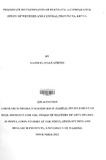| dc.description.abstract | The study aimed at finding out the contribution of the proximate determinants of fertility in Western and Central provinces using the 1983 Bongaarts fertility model. The general objective of the study was to find how proximate determinants of fertility have influenced'the level of total fertility in Western and Central provinces in 2008/09. Specifically the study was focused on examining the effects of demographic and socio-economic factors on fertility in Western and Central provinces among women aged 15-49 years in 2008/09 and estimating the extend of fertility inhibiting effects of the indices of each proximate determinants of fertility among women aged 15-49 years in Western and Central provinces in 2008/09.
The data used in the study was drawn from the Kenya Demographic and Health Survey (KDHS 2008-09). The type of information collected relevant to this study included; fertility levels, age at first marriage and birth, contraceptive prevalence, place of residence, wealth index and women's education level. The sample size involved was of and 8,444; women in 2008/09 both aged 15-49. There were three levels of computation procedures. There were three levels of computational procedures: First was the decomposition of proportional change in TFR into the components Pm, Pc, Pi, Pp and Pr using the Bongaarts Analytical Framework.
Secondly, running the frequencies and cross tabulations for demographic and socio-economic variables using SPSS to estimate their effect on fertility in the two regions, measures of the proximate determinants was then determined i.e. proportion of women married, proportion currently using contraceptive, average duration of postpartum infecundability, proportion of women aged 45-49 years who are infecund and average contraceptive use effectiveness. Lastly, estimation of the indices of Cm, Cc, Cp, and Ci against socio-economic and demographic characteristics in the two regions.
The findings of the study indicated that, as much as conteceptive use played a big role in fertility reduction in Central province with (Cc) being 0.62, marriage played the biggest role of the three principal proximate determinants in reducing fertility in the two regions. If all births were occurring in marital unions, as the formulation of the Bongaarts framework assumes, marriage would have a much stronger fertility inhibiting effect in fertility.
The index of primary sterility was not common enough to significantly lower aggregate fertility levels; Therefore Non-marriage (due either to delayed marriage or the exit from marriage) and prolonged use of contraceptives are the two most important factors that keep fertility below its biological maximum in Central province which Western province could highly emulate.
The predicted TFRs for Central and Western provinces were slightly different to the TFRs estimated from information on births in the last five years (3.5 compared to 3.4 in Central and 5.9 compared to 5.6 in Western). This difference between the model estimate and the observed value was consistent with the omission of the index of abortion, which was an important proximate determinant from the model. However, the result suggests that the proximate determinants included in the model were the principal mechanisms by which fertility was reduced below its biological maximum. The study recommends that efforts should be put on family planning programmes, women empowerment and education specifically to reduce fertility and enhance well being of
the family. | en_US |

